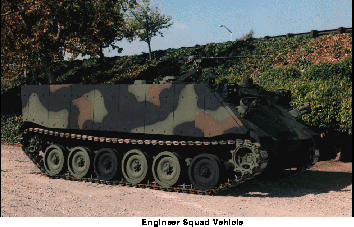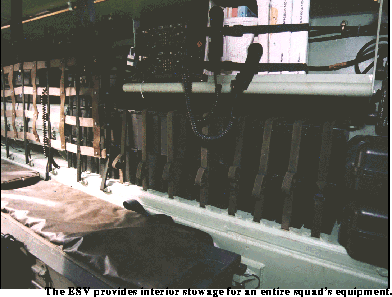
One of these deficiencies is being solved with the newly upgraded M113A2s, known as the M113A3, which selected units have already received. First introduced in 1987, the M113A3 features the Reliability Improvement for Selected Equipment (RISE) upgrade package. The RISE upgrades include replacing the existing 212-horsepower diesel engine in the M113A2 with a 275-horsepower turbocharged diesel engine, coupled with the X-200-4 trans-mission. This upgrade provides vehicle mobility roughly equivalent to that of the supported M1/M2 maneuver force.

The M113A3 has virtually the same mobility as the Bradley fighting vehicle and the Abrams main battle tank. However, even the M113A3 does not solve the engineer squad's basic dilemmas of stowage and survivability. Because of the amount of equipment they must carry, it is difficult for a fully loaded engineer squad to enter and exit a tracked vehicle easily.
Aproposal under consideration will solve the M113A2/A3 deficiencies. The Engineer School is seeking to replace them with a new engineer squad vehicle (ESV). It not only better meets combat engineer requirements but also is convertible from existing M113 systems. This vehicle modification program, supported by the M113 Program Management Office at the Tank-Automotive Command (TACOM), provides a superior squad vehicle at a much lower cost than a new acquisition.
The expanded hull configuration on the ESV prototype is based on the M113A3+ mobile tactical vehicle light (MTVL), which uses an M113 hull that is lengthened 34 inches and equipped with an additional road wheel (six on each side). The vehicle was developed as a "production-tooled demonstrator" with private-industry funding from United Defense.
An industry description notes that "The MTVL / ESV provides more than 60 cubic feet additional volume under armor and increases the payload capacity by up to 7,000 pounds beyond the M113A3. The vehicle's power train consists of a 350-horse-power turbocharged/aftercooled diesel engine driving through an electronically controlled, four-speed, automatic cross-drive transmission. The advanced suspension configuration and aggressive track design provide cross-country mobility that is superior to most combat vehicles over all terrain. Optional modular armor packages provide for up to 30-millimeter (mm) and rifle-propelled-grenade protection. Designed to retain the transportability features of the M113, the MTVL is C-130 roll-on/roll-off transportable and air-droppable."
The lengthened hull and significantly improved power train increase the MTVL's net payload capacity to almost 8 tons. In many cases, this increased capacity eliminates the current requirement for towing a squad equipment trailer or, in worst-case scenarios, for relying on tactical wheeled support vehicles to bring mission equipment forward.
There are significant suspension modifications to the vehicle's lower hull, such as rotating the final drives, raising the sponsons and idlers, and revising the spring and damping rates. In all cases, the new suspension system maintains 100-percent parts commonality with the current M113 vehicle fleet, which is important from both acquisition and supportability standpoints.
The increased payload capacity also allows the engineer squad to solve the remaining deficiency of insufficient battlefield survivability. The basic 5083 aluminum plate hull can be supplemented with a variety of armor packages, such as titanium and steel applique, spaced laminate steel, or ceramic armor tiles. The increased payload capacity is a tremendous advancement in under-armor stowage, while the ability to add things like titanium skin represents a giant leap forward in survivability.

The Engineer Center began testing the MTVL demonstrator in March 1995. Initial modifications to create the ESV config-uration involved changes to both internal and external stowage.
Internal Modifications.
External Modifications.
After the stowage modifications were made, the Engineer School used the ESV in a "heavy/light demonstration" at the ENFORCE XXI Conference at Fort Leonard Wood in April 1995. The vehicle supported troops from Fort Drum and Fort Bragg in a simulated assault on an objective. The ESV was one of several vehicles that demonstrated their individual capabilities and were later displayed for the assembled senior leaders.
Following the ENFORCE XXI demonstration, the ESV was assigned to Charlie Company of the 5th Engineer Battalion at Fort Leonard Wood for further testing and evaluation. Charlie Company's sergeant was the vehicle commander during subsequent field operations at Fort Bliss, Texas, (in support of the 3rd Armored Cavalry Regiment) and the National Training Center (NTC) at Fort Irwin, California.
Based on the field tests, the ESV satisfies a number of requirements that have been identified by engineer units. It-
Under-armor stowage was not a problem during the field tests. Although the squad size increased from 8 to 10 men with the addition of the Engineer Reconnaissance Acquisition Team, the men and their equipment-10 large rucksacks and duffel bags-fit inside the vehicle. During the live-fire phase at the NTC, the ESV also carried a case of live C4, a roll of detonation cord, blasting caps, three bangalore sections, the platoon's NBC (nuclear, biological, and chemical) warning equipment, weapon tripods, spare barrel bags, ammunition, and regular engineer equipment (three shovels, three axes, picks, and the pick mattock). It all fit in the vehicle, either strapped down or inside the box. Additional equipment could have been loaded inside if they had strapped the rucksacks to the top and sides of the vehicle. As the mission of combat engineers continues to expand and new equipment is introduced, the need for safe and accessible stowage will continue.
The ESV retains the ability to pull a trailer since some tactical scenarios, such as a rapid transition from offense to defense, could require transportation of additional mines or barrier material. On one field mission, when the unit carried mines and wire to facilitate transition to a defensive operation, the vehicle proved it was up to the challenge. The unit had all its equipment, pulled a trailer, and still kept up with the tanks.
The longer hull of the ESV even facilitates sleeping arrangements in the field. Because of restrictions at NTC about sleeping on the ground, the entire unit slept comfortably in or on the ESV-seven of them inside and three on top. If someone below felt too crowded, he could move to the top of the hull.
The Engineer School's requirements document formalizing the need for the ESV is currently in the sign-off process. Funding to transition the engineers from the M113A3 upgrade program to the M113A3+ ESV program has not been identified yet. With approximately 84 engineer vehicles required in a modern mechanized division, TACOM sources indicate that the initial ESV requirement could range from 300 to 400 vehicles.
U.S. Army combat engineers must continue to update their battlefield equipment. They have long needed an improved squad carrier that provides optimum support to front-line forces. A critical component of the combat engineer system, a carrier serves as a work room, bunker, power tool, and fighting platform for the squad. The ESV will finally provide engineers the capability to support the modern maneuver forces in today's fast-paced conflicts.
Major Gourley is an individual mobilization augmentee. He is a graduate of the Field Artillery Officer Basic and Advanced Courses.